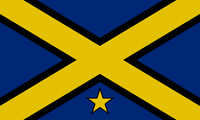Ædhige: Difference between revisions
No edit summary |
|||
| Line 236: | Line 236: | ||
--> | --> | ||
==Syntax== | ==Grammar== | ||
=== | ===Syntax=== | ||
=== | ==Word order== | ||
=== | ==Initial mutations== | ||
=== | ==Questions and answers== | ||
=== | ==Imperative== | ||
==Passive voice== | |||
==Subordination== | |||
===Nouns=== | |||
===Articles=== | |||
===Adjectives=== | |||
===Pronouns=== | |||
==Personal pronouns== | |||
==Possessive determiners== | |||
==Intensive pronouns== | |||
===Prepositions=== | |||
===Verbs=== | |||
=='To be'== | |||
==Present tenses== | |||
==Future tenses== | |||
==Past tenses== | |||
==Conditional tenses== | |||
<!-- etc. etc. --> | <!-- etc. etc. --> | ||
| Line 271: | Line 288: | ||
[[Category:{{PAGENAME}}]] | [[Category:{{PAGENAME}}]] | ||
[[Category:Languages]] | [[Category:Languages]] | ||
[[Category:Indo-European_languages]] | |||
[[Category:Celtic_languages]] | |||
Revision as of 17:20, 23 July 2017
| Ædhige | |
|---|---|
 The flag of the Ædan Islands | |
| Pronunciation | [/ˈæːðɪgə/] |
| Created by | – |
| Native to | The Ædan Islands, natively Ædanir ('the islands') |
| Native speakers | around 1,200,000 (2017) |
Early forms | |
Introduction
Ædhige is a Celtic language of the Indo-European language family originating on the Ædan Islands in the North Atlantic Ocean. It is spoken by the Ædhici, a group of around 1.2 million people. The majority live on the four biggest islands: Ædan Mhur ('big island'), Ædan Mhic ('little island'), Læchem (from the Old Ædhige for 'mines by the lake'), and Ædan Lhua ('sun island'), although the archipelago has another 10 smaller inhabited islands, all with populations of under 50 people.
The language can trace its roots to Proto-Celtic but due to the isolated location of the archipelago from the rest of Europe, Ædhige became a distinct language in the first century CE. Over the centuries the language has been influenced by other Celtic languages - namely Irish due to its proximity to the islands; and Germanic languages - namely Old Norse and English.
Phonology
Orthography
Ædhige is written with the Latin alphabet and consists of 26 distinct letters, including 4 digraphs:
A B C D DC DH E F G H I L M N O P R S SC T TC U V W Æ Œ
Although not distinct letters in their own right, all vowels except æ and œ can carry a grave accent. This results in the preceding consonant undergoing palatalization:
À È Ì Ò Ù
Consonants
Ædhige has the following consonant phonemes:
| Labial | Dental | Alveolar | Post-alveolar | Palatal | Velar | Uvular | Glottal | |||
|---|---|---|---|---|---|---|---|---|---|---|
| central | lateral | |||||||||
| Nasal | voiceless | |||||||||
| voiced | m | n | ɲ | ŋ | ||||||
| Plosive | voiceless | p | t | k | ||||||
| voiced | b | d | ɡ | |||||||
| Affricate | voiceless | t͡ʃ | ||||||||
| voiced | d͡ʒ | |||||||||
| Fricative | voiceless | f | s | ɬ | ʃ | (χ) * | h | |||
| voiced | v | ð | z | ɣ | ||||||
| Trill | voiceless | r̥ | ||||||||
| voiced | r | |||||||||
| Approximant | voiceless | ç | ||||||||
| voiced | l | j | w | |||||||
^ [χ] only present in certain dialects.
VowelsProsodyStressIntonationPhonotacticsMorphophonologyMorphologyGrammarSyntaxWord orderInitial mutationsQuestions and answersImperativePassive voiceSubordinationNounsArticlesAdjectivesPronounsPersonal pronounsPossessive determinersIntensive pronounsPrepositionsVerbs'To be'Present tensesFuture tensesPast tensesConditional tensesExample textsOur Lord's Prayer - Ara Gia Dcæu
Other resources |